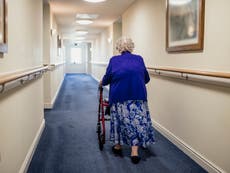‘Light at the end of the tunnel’: Boris Johnson holds out hope of normal Christmas but admits flaws in Covid testing system
Tracers reaching fewer than 60 per cent of close contacts, new figures show
Your support helps us to tell the story
From reproductive rights to climate change to Big Tech, The Independent is on the ground when the story is developing. Whether it's investigating the financials of Elon Musk's pro-Trump PAC or producing our latest documentary, 'The A Word', which shines a light on the American women fighting for reproductive rights, we know how important it is to parse out the facts from the messaging.
At such a critical moment in US history, we need reporters on the ground. Your donation allows us to keep sending journalists to speak to both sides of the story.
The Independent is trusted by Americans across the entire political spectrum. And unlike many other quality news outlets, we choose not to lock Americans out of our reporting and analysis with paywalls. We believe quality journalism should be available to everyone, paid for by those who can afford it.
Your support makes all the difference.Boris Johnson today said he hoped Britain can have “as normal a Christmas as possible”, but admitted that failings in the test and trace system are holding back the fight against coronavirus.
Speaking as England entered its second national lockdown, the prime minister repeated his intention to ease restrictions on 2 December, promising voters that there is “light at the end of the tunnel”.
But he admitted that the crucial test and trace system run by Tory peer Dido Harding had been taking too long to return results and was failing to persuade people to self-isolate after coming into contact with contagious individuals.
Data released on Thursday showed that NHS Test and Trace in England was reaching fewer than 60 per cent of close contacts of people infected with the coronavirus.
This was the second lowest figure since the private sector-operated system began, and far below the 80 per cent needed for it to be effective.
For cases handled by local health protection teams, 97.9 per cent of contacts were reached and asked to self-isolate. But for cases processed online or by call centres, this figure was 58.5 per cent.
Just 26.4 per cent of people tested at regional and local sites or mobile testing units in the week ending 28 October received their result within 24 hours.
This is up from 22.6 per cent in the previous week but still lower than in June, when Mr Johnson promised a 24-hour turnaround for all in-person tests by the end of the month.
Official figures showed a total of 1,482,528 people were tested that week and 137,180 confirmed as positive. The rate of 9.3 per cent positive tests was the highest since the start of the pandemic, and well above the 5 per cent level which the World Health Organisation regards as an indicator that the disease is not under control.
Speaking at a 10 Downing Street press conference, Mr Johnson rejected the suggestion that the much-criticised system was having “no impact” on the pandemic.
But he said: “Of course I understand people’s frustrations with NHS Test and Trace. It has come in for a lot of criticism and clearly it has taken too long for people to get their results sometimes.”
He added: “One of the real problems we have had is getting people to self-isolate in the way they need to.”
Recent studies have shown that as few as 20 per cent of those told to self-isolate actually complete the required 14 days of quarantine in their homes.
Mr Johnson insisted that the performance of test and trace was improving, with turnaround times “getting better rapidly”.
The programme’s capacity for more than 500,000 tests a day made it “the biggest diagnostics … capacity anywhere in Europe”, he said, even though the most recent figures show just 265,024 of those tests were actually used on Tuesday.
“Yes, it hasn’t had as much impact as we would have wanted,” said the prime minister. “But there’s no doubt that by identifying people who have the disease, identifying the localities where people have the disease, we’ve been able to get the R down in a way that I don’t think we would otherwise have done.
“So, it’s had an effect in helping to reduce the spread.”
Mr Johnson told the press conference he believed the four-week lockdown would be enough to make a “real impact” on the spread of the disease and bring the reproduction rate – known as R – below the crucial level of one.
Acknowledging that many people are “anxious, weary and fed up”, he insisted: “These rules will expire and on 2 December we plan to move back to a tiered approach.
"There is light at the end of the tunnel. These are difficult times. While it pains me to have to ask once again for so many to give up so much, I know we can get through this.”
And he added: “If we follow this package of measures in the way that we can and we have done before, I have no doubt people will be able to have as normal a Christmas as possible and that we will be able to get things open before Christmas as well.”
Standing alongside the PM, NHS England chief executive Sir Simon Stevens said that the second wave of coronavirus “is real and it’s serious”.
The 11,000 coronavirus patients currently in hospital was enough to fill 22 hospitals, and Sir Simon compared it to 7,000 cancer patients being looked after on a normal day and 3,000 flu sufferers at the peak of the winter season.
Around 30,000 staff in the health service were either off with the coronavirus or having to self-isolate, said Sir Simon before he added: “That has an impact.”





Join our commenting forum
Join thought-provoking conversations, follow other Independent readers and see their replies
Comments